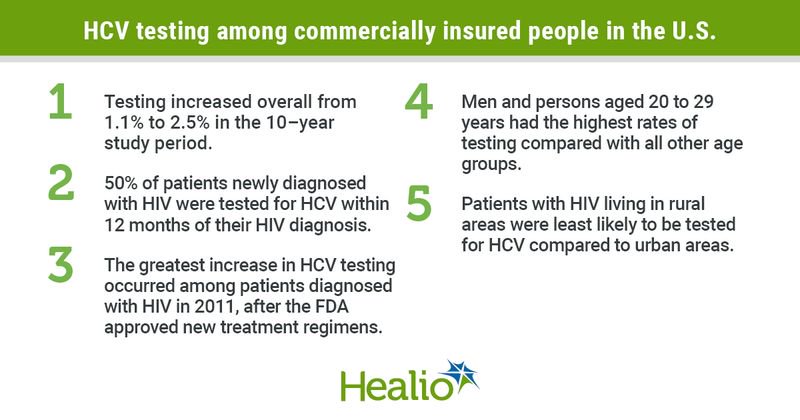Data reveal ‘missed opportunities’ to detect HCV among newly diagnosed patients with HIV
Among commercially insured patients in the United States, only 50% of those newly diagnosed with HIV underwent hepatitis C testing within 12 months of their diagnosis, according to data published in Open Forum Infectious Diseases.
Researchers noted that despite the increases in overall hepatitis C testing rates, the data show “missed opportunities” to detect HCV infection among people newly diagnosed with HIV.

“Since 1999, hepatitis C testing has been recommended for persons with HIV,” Hope King, PhD, MSPH, epidemiologist in CDC’s Division of Viral Hepatitis, told Healio. “Because HIV infection can accelerate the natural history of HCV infection — leading to increased risk for cirrhosis, liver failure and hepatitis C-related mortality — we sought to explore the frequency and rates of hepatitis C testing among individuals newly diagnosed with HIV infection.”
King and colleagues analyzed data from the 2003-2017 IBM Watson Health MarketScan database, using diagnostic, procedural and drug codes to identify patients with at least one inpatient or outpatient medical claim of HIV diagnosis. The researchers then calculated HCV testing rates among individuals with newly diagnosed HIV within 12 months of the initial HIV diagnosis date and identified factors associated with HCV testing.
According to King, 50% of newly diagnosed patients with HIV were tested for HCV within 12 months of their HIV diagnosis. HCV testing rates increased unevenly over the study period, with the greatest increase, a 6% increase, occurring among patients diagnosed with HIV in 2011 (46%) and those diagnosed in 2012 (52%), after new treatment regimens were approved by the FDA.
Significant predictors of HCV testing included age, sex and urbanicity. According to the study, women with HIV were less likely to have been tested than men (adjusted risk ratio = 0.79; 95% CI, 0.77-0.81). The study also determined age was a factor, with only 40% of patients aged 50 to 59 years tested for HCV within 12 months of the index HIV diagnosis compared with 56% of patients aged 20 to 29 years.
“Because HIV infection can accelerate hepatitis C-related morbidity and mortality, additional efforts are needed to improve hepatitis C testing among people newly diagnosis with HIV,” King concluded.
